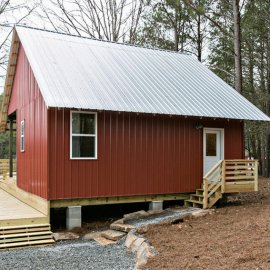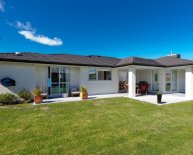
Cheap new House
 The goal: To figure out how to bring the ultra-low-cost homes, called the 20K Home, to the broader market. "We're in a kind of experimental stage of the program, where we're really trying to find out the best practice of getting this house out into the public's hands, " says Rusty Smith, associate director of Rural Studio. "Really this first field test was to find out all the things that we didn't know, and to find out all of the kind of wrong assumptions that we had made, and really find out how we had screwed up, honestly."
The goal: To figure out how to bring the ultra-low-cost homes, called the 20K Home, to the broader market. "We're in a kind of experimental stage of the program, where we're really trying to find out the best practice of getting this house out into the public's hands, " says Rusty Smith, associate director of Rural Studio. "Really this first field test was to find out all the things that we didn't know, and to find out all of the kind of wrong assumptions that we had made, and really find out how we had screwed up, honestly."
Years of architecture students, and their advisors, have spent more than a hundred thousand hours tweaking each detail of the house to optimize both the function and the price. But the bigger challenge is fitting a house that's completely different than normal into the existing system of zoning, and codes, how contractors do their jobs, and even mortgages.
"The houses are designed to appear to be sort of normative, but they're really high-performance little machines in every way, " says Smith. "They're built more like airplanes than houses, which allows us to have them far exceed structural requirements. We're using material much more efficiently. But the problem is your local code official doesn't understand that. They look at the documents, and the house is immediately denied a permit simply because the code officials didn't understand it."
 The foundation of the house, for example, uses cantilevers, seesaw-like joists that help save wood and concrete and actually make the house stronger than a typical foundation would. But the design isn't in the usual guides that code officials consult, so the architects had to go back and explain how it worked.
The foundation of the house, for example, uses cantilevers, seesaw-like joists that help save wood and concrete and actually make the house stronger than a typical foundation would. But the design isn't in the usual guides that code officials consult, so the architects had to go back and explain how it worked.
"There's a thousand and one things in the houses that are like that, " he says. "You'd never see them, the construction techniques, but the house is filled with them. Construction techniques that make the house not just less expensive, but actually makes it perform better than they normally would."
To bring the house to everyone else who wants to build it, the team realized they would have to create a detailed guide that explained everything from how to build each piece—with Ikea-like instructions—to how to educate local officials.
 "A traditional construction set basically tells a builder what to build, " says Smith. "And what we learned that we really need is what we've come to refer to as not a construction set, really an instruction set. That not just tells what to build, but specifically how to build it and even more important, why it should be built that way."
"A traditional construction set basically tells a builder what to build, " says Smith. "And what we learned that we really need is what we've come to refer to as not a construction set, really an instruction set. That not just tells what to build, but specifically how to build it and even more important, why it should be built that way."
In Serenbe, their first problem was a zoning issue: The houses were too small. (It's a common problem for anyone trying to build a tiny home.) But they also realized there were numerous other issues, from dealing with insurance, to the bank. In the pilot project, the homes will be owned by the community and shared with artists as part of a residency program. But in a typical case, when someone is buying the house on a limited income and can't afford the $20, 000, banks won't finance a mortgage for such a small amount of money.
The most daunting problems aren't brick and mortar problems, they're these network and system problems.Regions Bank, which works with Rural Studio, told Smith that a mortgage for a $100, 000 house costs the bank about $2, 300. But a mortgage for a $20, 000 house also costs $2, 300. "There's a lack of scalability, " Smith says. "There are these structural things you can only scale down so far." Now the bank has worked on their own design problem: a new mortgage product made for the poorest people to afford.



















